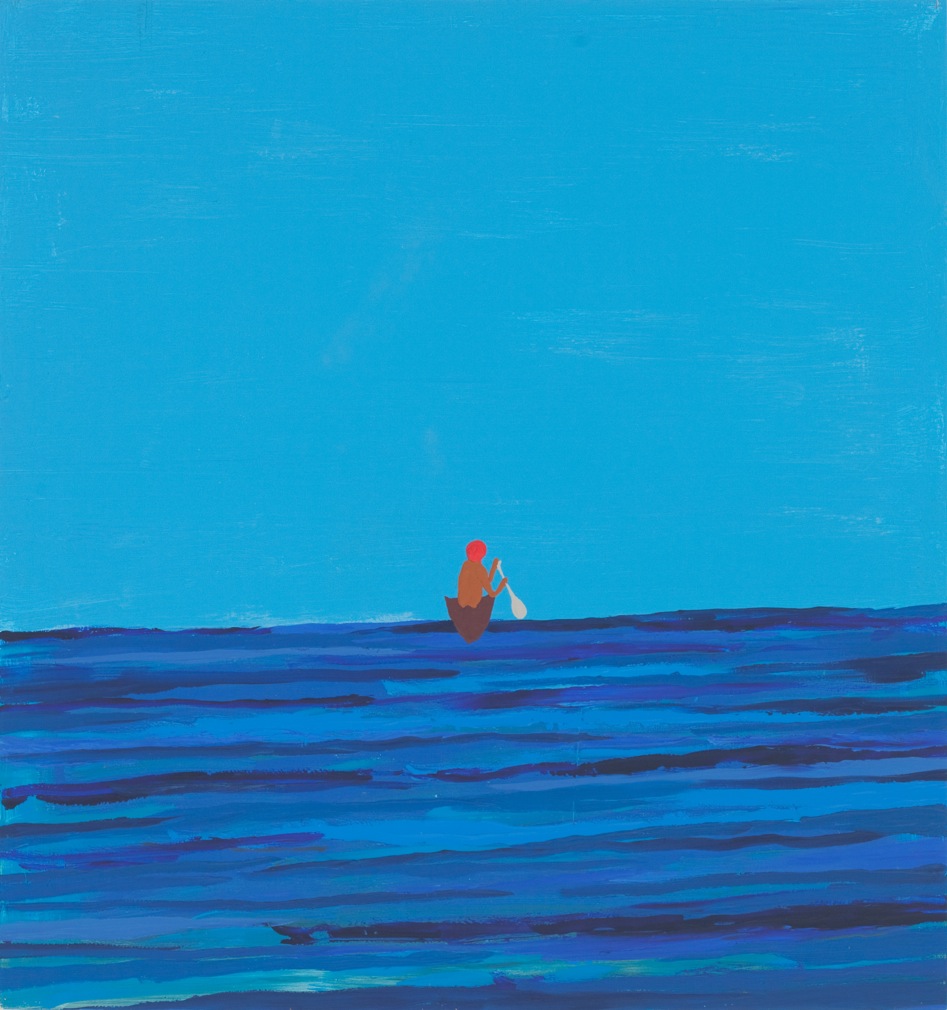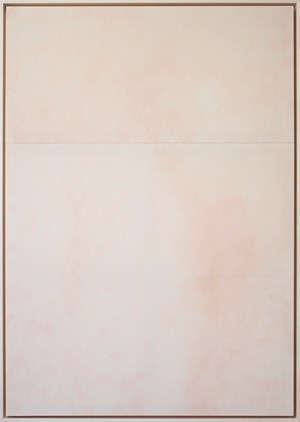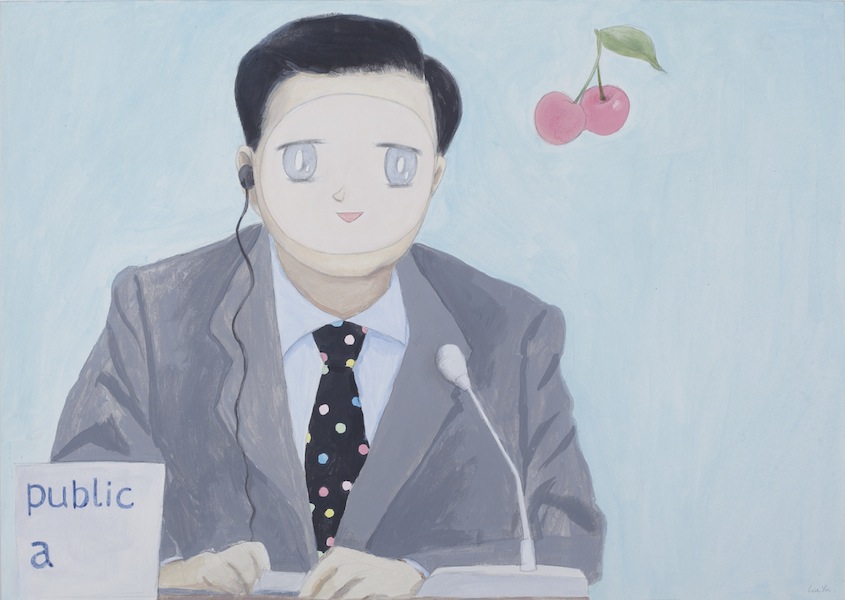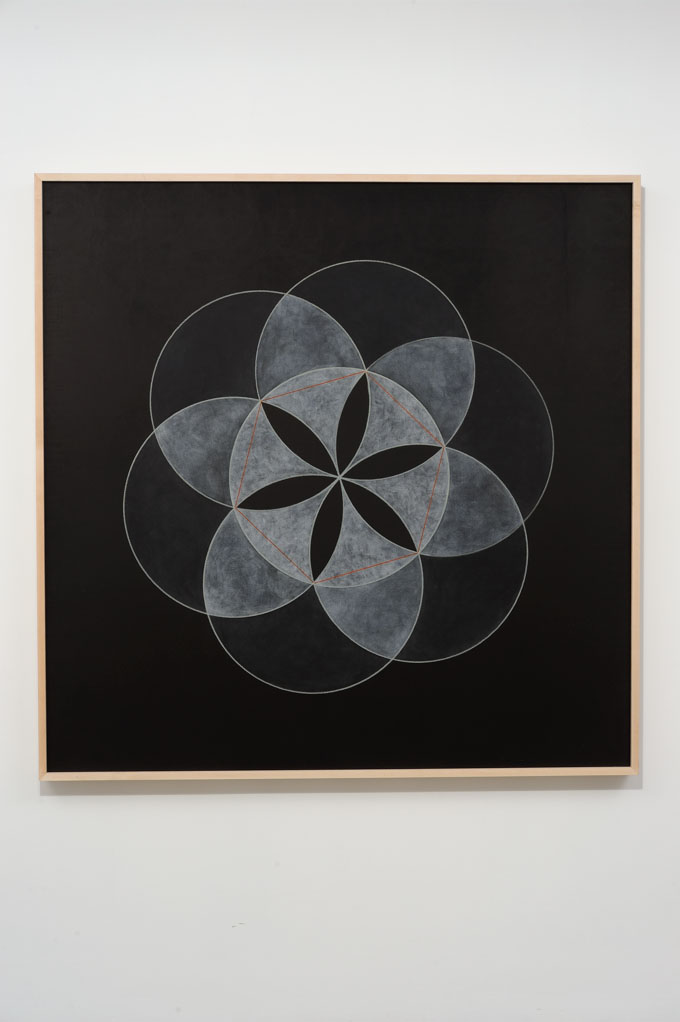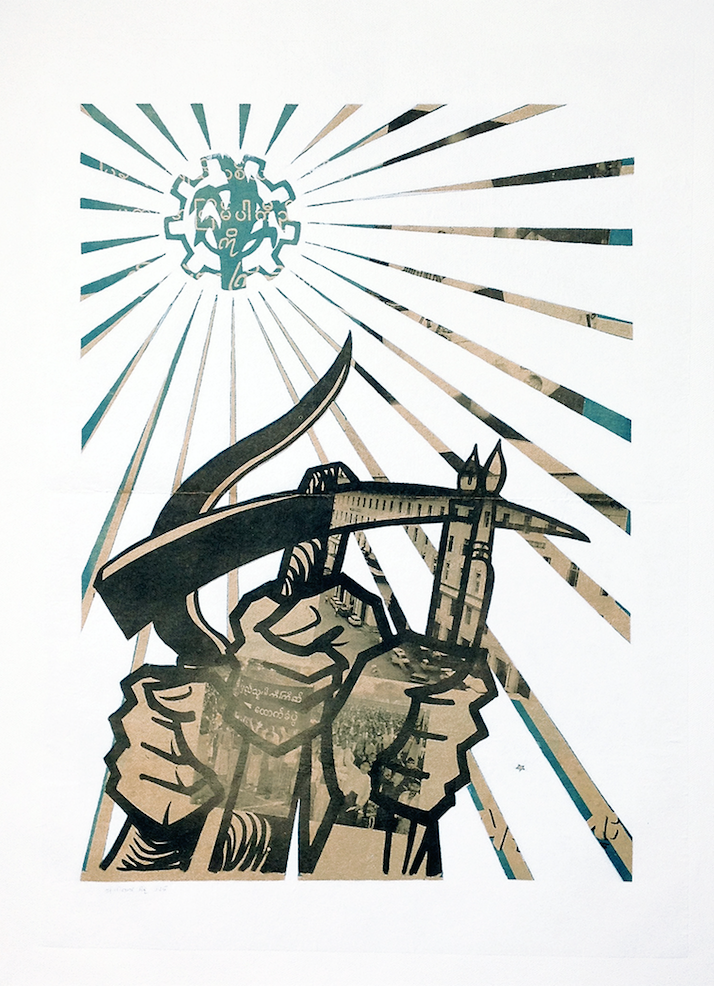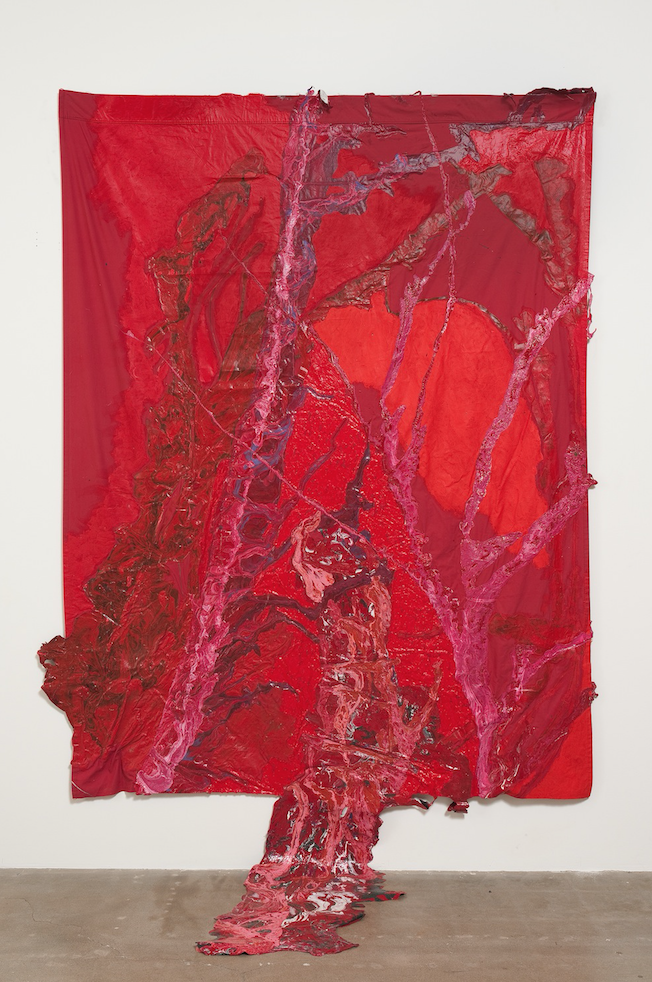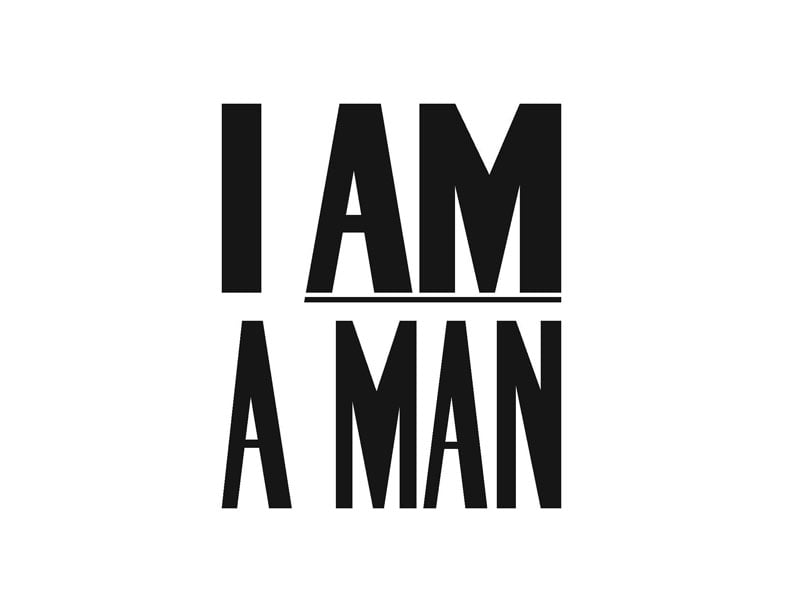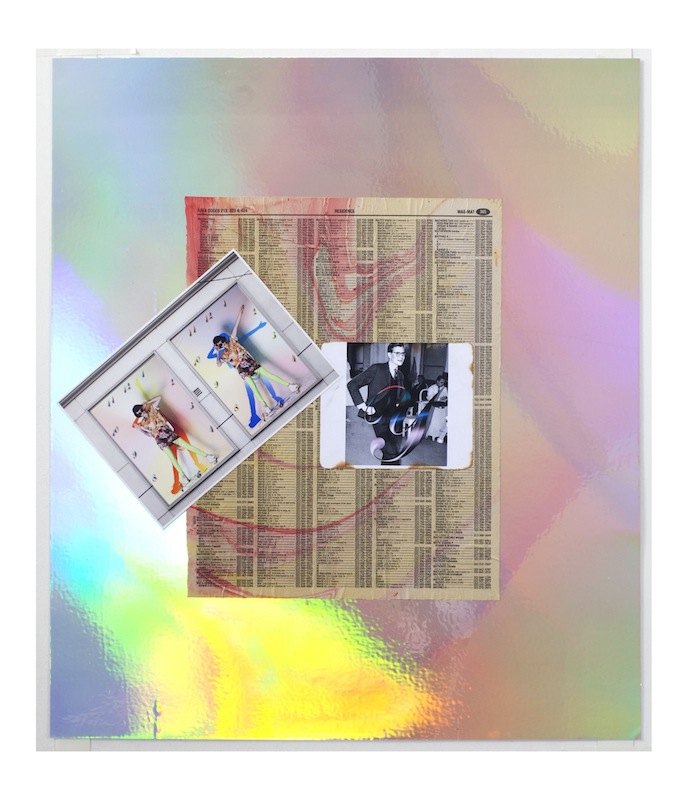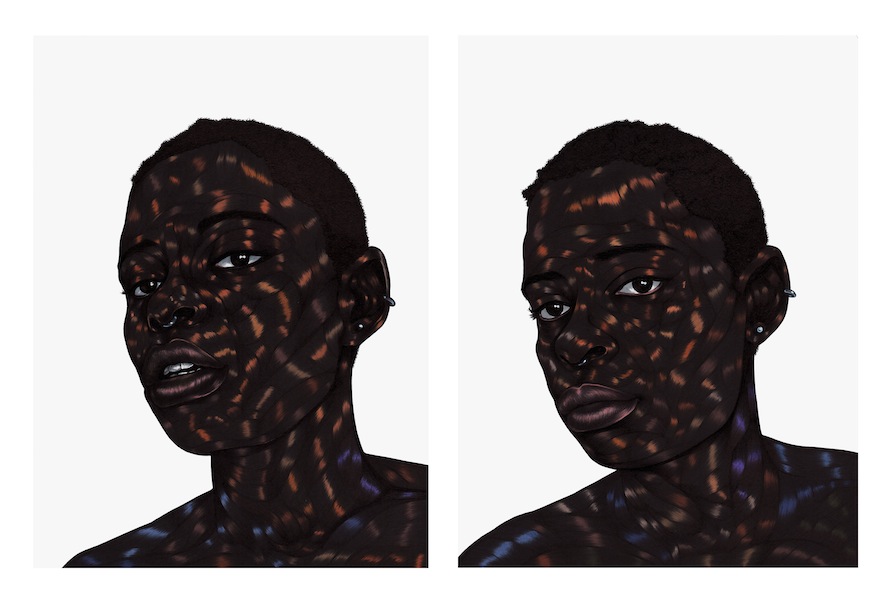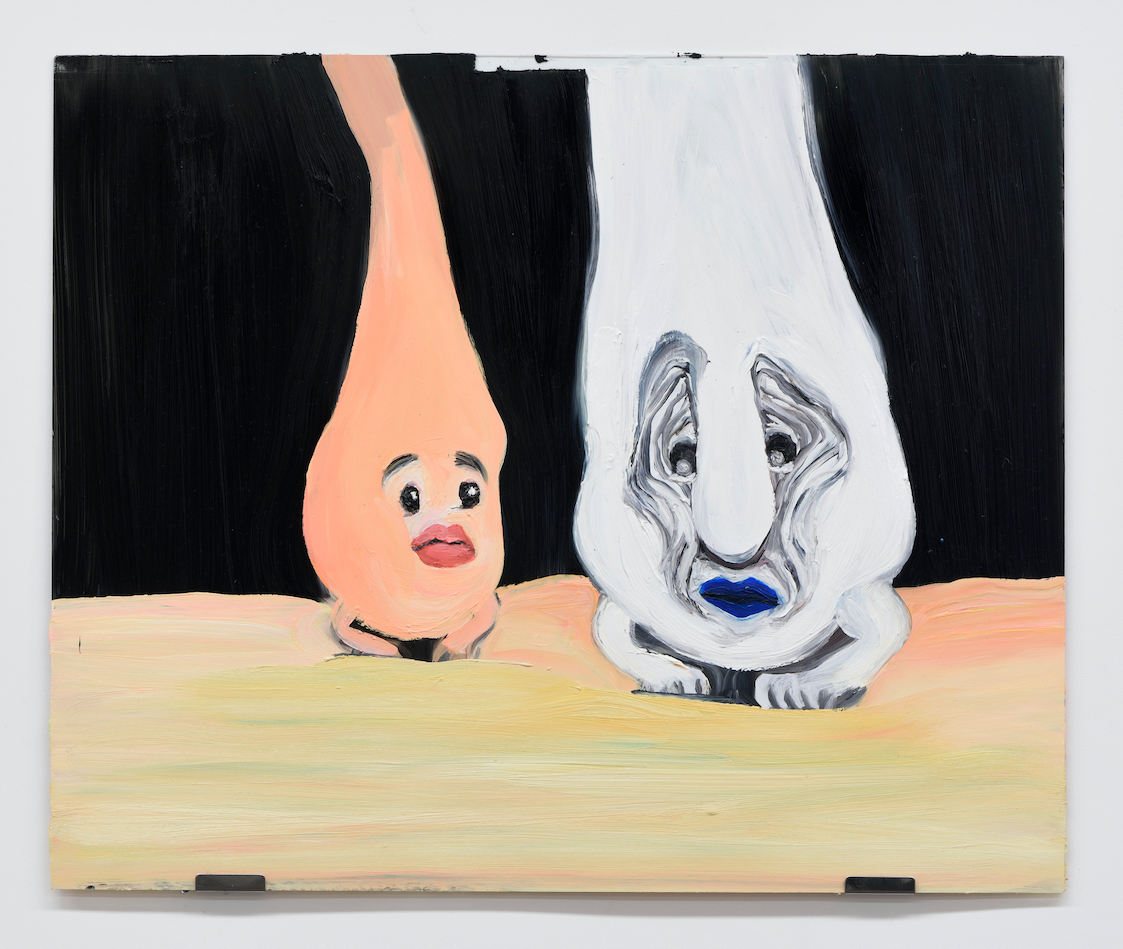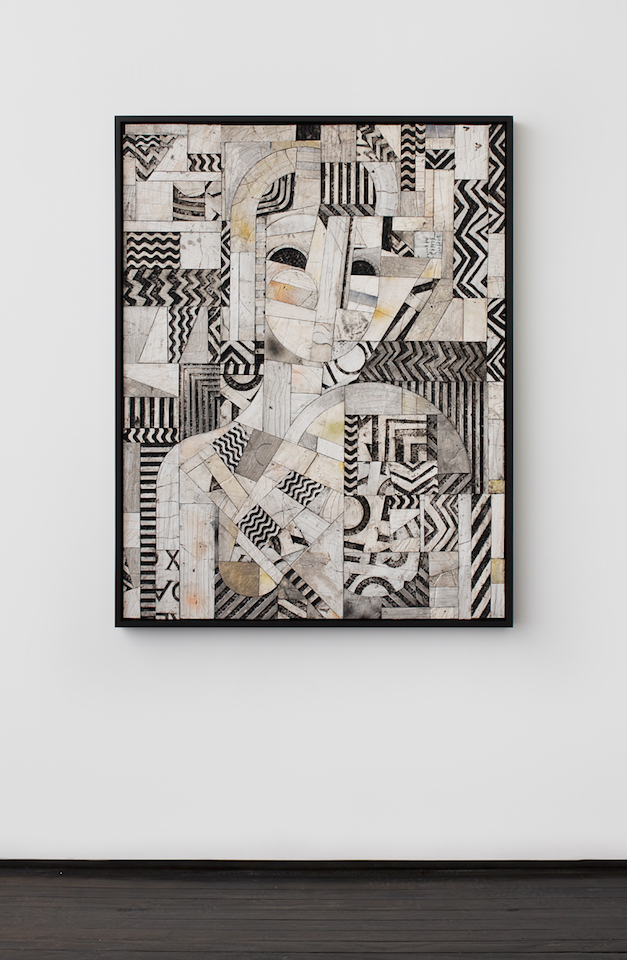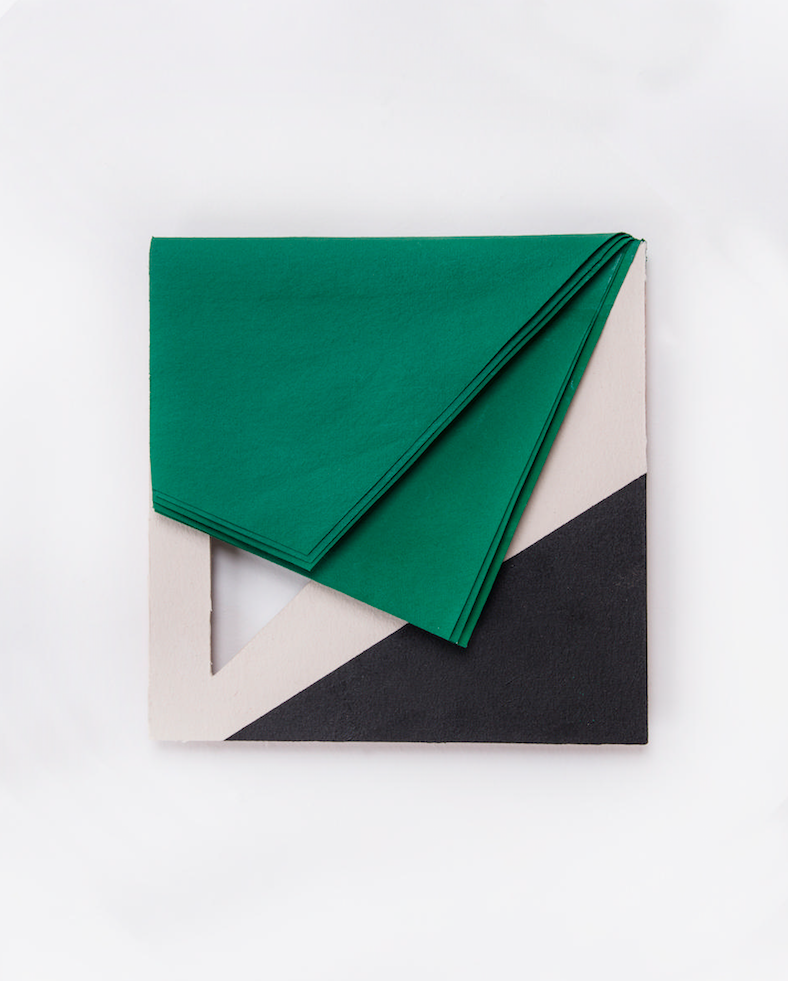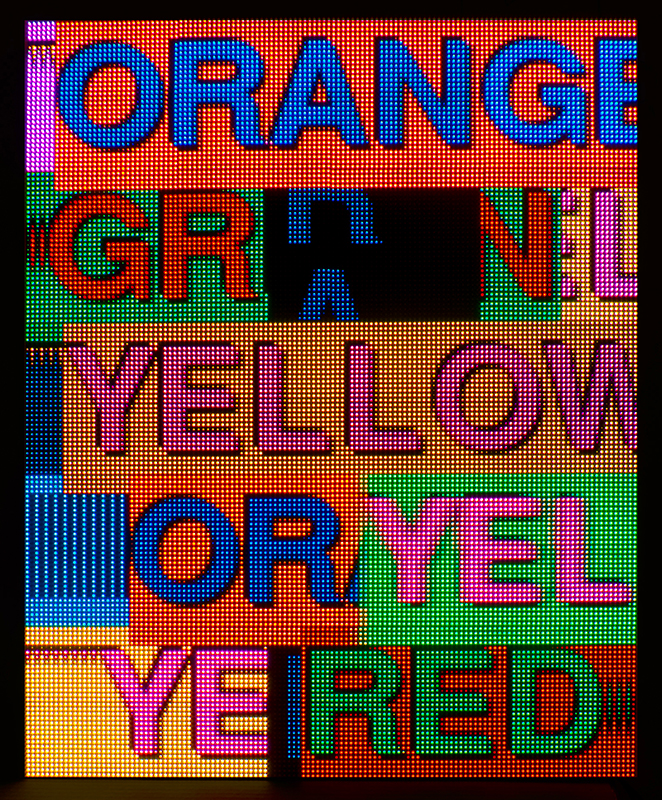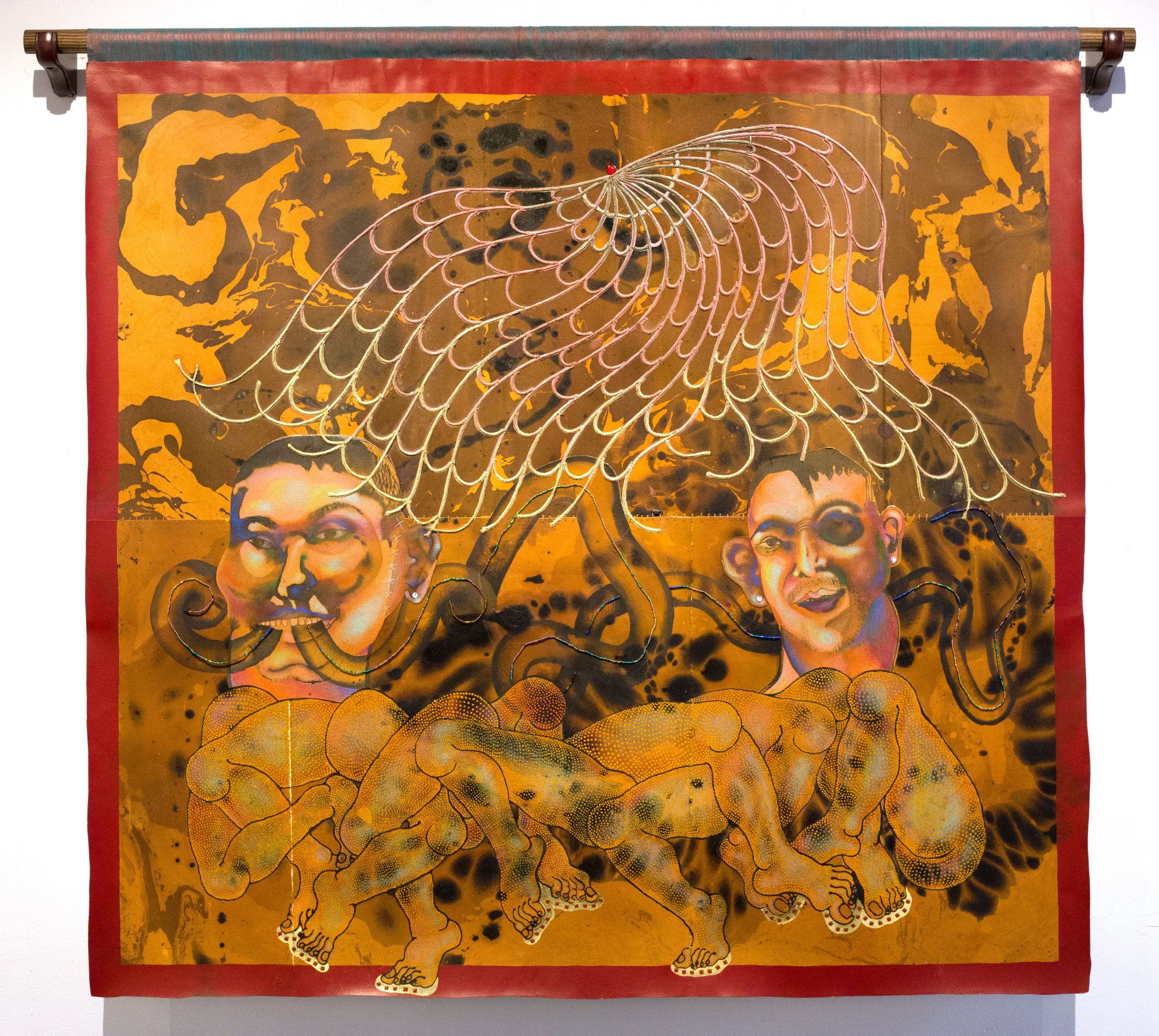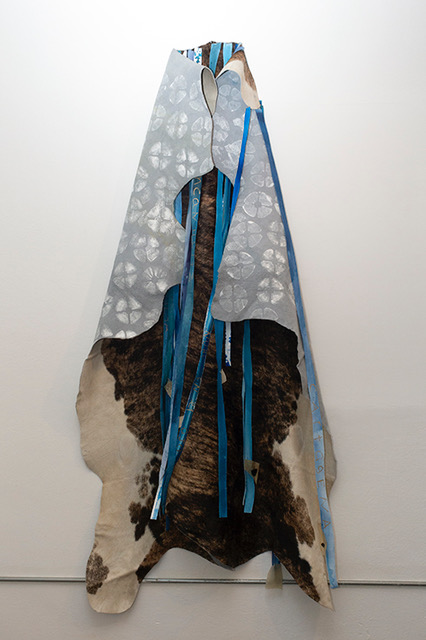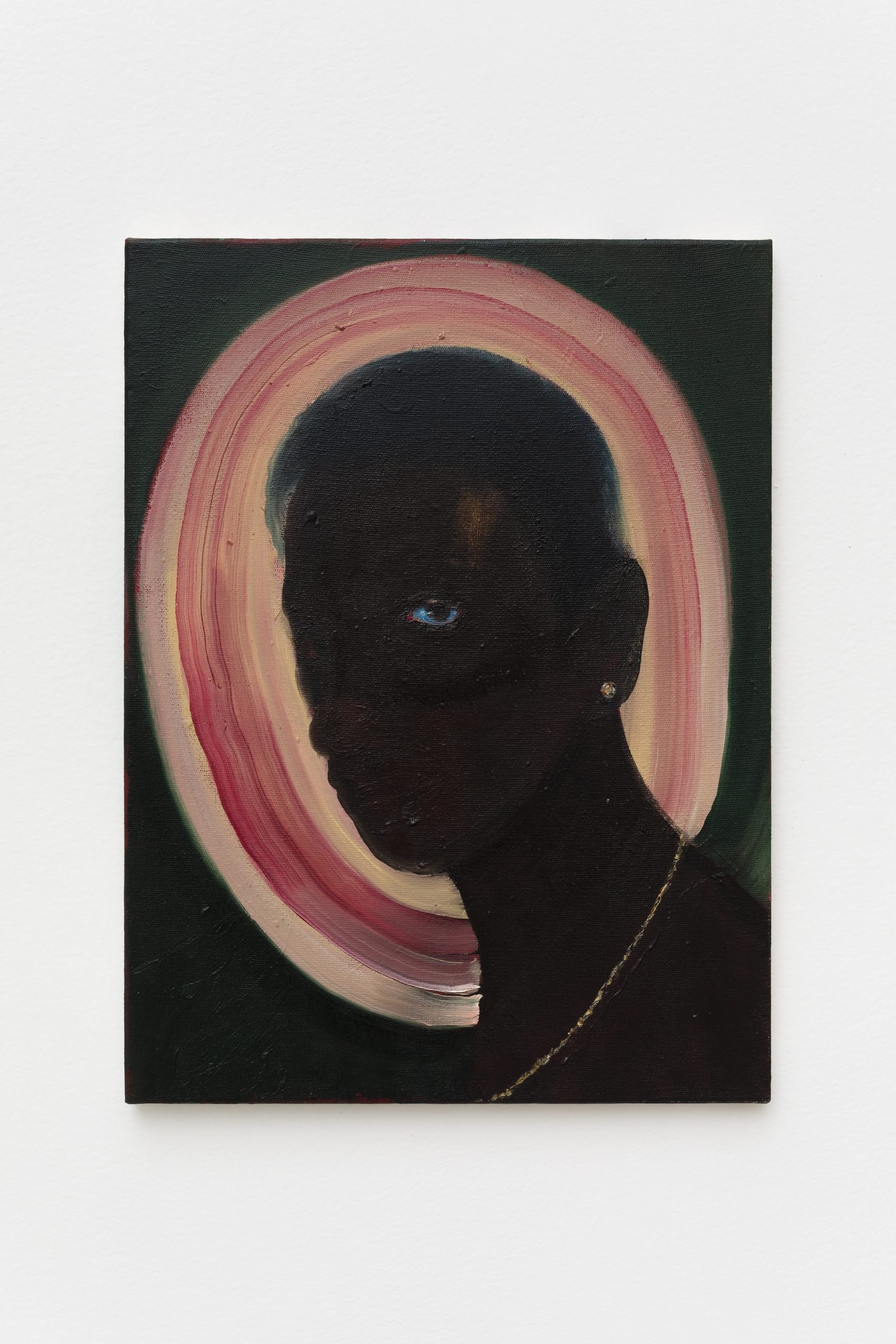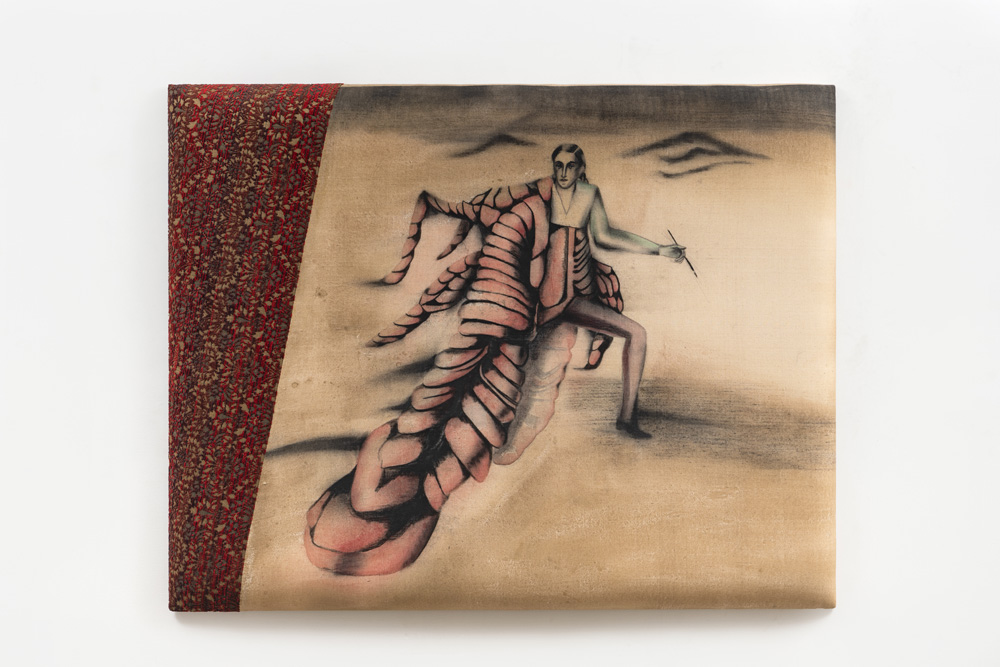
© » KADIST
Jessica Warboys
The ongoing “Sea Paintings” series is central to the practice of Jessica Warboys. The series plays with the notion of ritual, performance, nature and consequence. The artist realises her “Sea Paintings” on the Zennor coast, near St Ives, where she emerges the canvas in the seawater, allowing the waves and the wind to mix the raw mineral pigments that have been applied by hand to damp folded canvases.

© » KADIST
Matti Braun
During a residency in 2009 at L’appartement 22 in Rabat, the artist traveled in Morocco and Senegal on the traces of the German sculptor Arno Breker. On this occasion he learned about batik, a fabric printing technique which originates not only from Indonesia but also from Senegal. It is also widespread in Africa.

© » KADIST
Hun Kyu Kim
Readymade Flea Market is part of a series of works developed by Hun Kyu Kim. While the artist’s previous work drew a parallel between capitalism’s inherent social violence and the evolution of weaponry, Hun Kyu Kim now focuses on political nihilism and how to overcome it. In this new work he uses the metaphor of 3D Graphic Space to represent our current reality.

© » KADIST
Kapwani Kiwanga
Kapwani Kiwanga’s Linear Painting series (2017) reflect the artist’s research into disciplinary architecture, including schools, prisons, hospitals, and mental health facilities. When they were presented together, the paintings were arranged according to a black horizontal line placed at 160 centimeters from the floor, which traced the entire perimeter of the gallery. According to hygiene standards in Europe, this would mark the height below which walls should be washed in order to prevent the spread of illnesses.

© » KADIST
Jarrett Key
Jarrett Key’s practice combines several modes of production into a single frame, incorporating sculpture, painting, and performance. Dancing Free I , painted in wet cement, like a fresco, is part of a current series of paintings titled Leaving the City , which depicts Black people they know in lush, pastoral landscapes. Raised in rural Alabama, Key’s series grew out of a few experiments conducted with visitors to their studio.

© » KADIST
Fred Wilson
Fred Wilson’s flag paintings document the 20th century history of African people, indexing the period of liberation from colonialism. As the majority of African flags were created during the 1950s and 60s, they were intended to reflect a so-called ‘modern’ aesthetic and ideology. Many African flags maintain the typical flag tropes such as stripes, stars, birds, and blocks of primary and secondary colors; green to represent the land; blue to symbolize the ocean or sky; and red to recall the violence that occured in the pursuit of liberty.

© » KADIST
Imran Qureshi
At first glance, This Day by Imran Qureshi appears to be an energetic, gestural painting reminiscent of Action Painting from the mid-20th century. But upon closer inspection, highly detailed floral elements reveal themselves amongst the bold red brushstrokes. The botanical motifs in Qureshi’s work represent life and regeneration while the red paint refers to death and mortality.

© » KADIST
Etel Adnan
Adnan’s paintings are simple images with bold contrasting colors and rich textures. This particular work has an iconic feel and a strong physical presence in spite of its diminutive size. All of her paintings are small but, like Howard Hodgkin’s work, their intensity gains from their diminutive size.
![Resurgimiento [Resurgence]](https://kadist.org/wp-content/uploads/2023/01/IMG_Resurgence-Acrylic-on-canvas-135-x-67cm-scaled.jpg)
© » KADIST
Wynnie Mynerva Mendoza Ortiz
Wynnie Mynerva places their body at the center of their practice from an intimate perspective and healing dimension. Their paintings are thresholds where body parts proliferate beyond names and labels, dissolving and intermingling gender marks, organs, and prostheses. Resurgimiento [Resurgence] was produced in the aftermath of their fifth solo show Closing to Open (Galería Ginsberg, Lima, 2021), in which Mynerva addressed their experience of going through a vaginal surgical procedure to help them feel more aligned with their gender identity.

© » KADIST
Karen Lamassonne
Ventana indiscreta (Rear Window) by Karen Lamassonne takes its title from Hitchcock’s renowned 1954 classic. The painting is part of Lamassinne’s Homenaje a Cali [Homage to Cali] series, developed by the artist in 1989 in a nostalgic attempt to immortalize Cali at a time in which violence from drug trafficking had rendered it unlivable, and the generation that Lamassone had lived it up with had all but dispersed. Lamassone had formally established in Cali around the middle of the decade at a time in which the hangover from the 1971 Pan-American Games and an artistic effervescence had transformed it from a provincial sleepy town into a newly discovered urban (and sexual) labyrinth, one that was fit for the artist’s own explorations around its representation.

© » KADIST
Alexandre da Cunha
His Deck Painting I recalls the simplistic stripes of conceptual artist Daniel Buren, or the minimal lines of twentieth century abstract painting, but is in reality a readymade, fashioned from repurposed fabric of deck chairs. Alexandre da Cunha reinvents found objects in surprising ways that combine the material characteristics of Arte Povera with the concerns and techniques of painting. Da Cunha’s work often features flags—either as a found material per se or as a constructed form—that reflect the artist’s interest in issues of nationality, governmental politics, allegiance, and culture.

© » KADIST
Prabhakar Pachpute
Calling attention to campaigns for land rights, survival, and sovereignty, Prabhakar Pachpute’s recent works consider how farmers in India use their bodies in performative ways during acts of protest. The oil painting Inclined uncertainties depicts a grotto-like city atop a boat carried by headless human bodies. The waterless boat navigates through a desolate landscape, propelled forward by the faceless humans, who appear to be holding the cumbersome structure together.

© » KADIST
Eric Dizambourg
Like the film Le Mouton noir, this dimension is counterbalanced by a burlesque element. The piece of fabric on the rat’s paw or ‘graft’ becomes a patchwork made out of colorful geometric shapes recalling a Harlequin costume, thus referring directly to the burlesque tradition. This leitmotiv creates a contrast with the dull colors, the humility of the countryside, and makes the figurative scene look unreal to reveal its superficiality.

© » KADIST
Abel Rodríguez
Abel Rodríguez’s precise, botanical illustrations are drawn from memory and knowledge acquired by oral traditions. They are the visions of someone who sees the potential of plants as food, material for dwellings and clothing, and for use in sacred rites. Terraza Alta V is part of a series of drawings that track the changing appearance and life of an area identified as Terraza Alta.

© » KADIST
Chris Duncan
Taken from the title of the incredibly influential punk/hardcore record I AGAINST I by the Bad Brains, Untitled (blue) is an acrylic painting on reflective paper by Chris Duncan is part of a larger body of work titled EYE AGAINST I . This title references Duncan’s early artistic influences from the punk and hardcore music communities in tandem with his conceptual interest in perception and optics. This small painting features a glowing cluster of colorful dots on a bright blue background, also created from an accumulation of blue dots in varying tones.

© » KADIST
Firenze Lai
Central Station, Alignment, and Sumo are “situation portraits” that present whimsical characters within distorted and troubling worlds. These portraits explore the relationship between the psyche and contemporary social environments, focusing on isolation, identity, and distress. Central Station shows a character reaching to wipe a tear from her face as the blues of her wardrobe seem to blend in with the dismal blue of the background.

© » KADIST
Juan Capistran
White Minority , is typical of Capistran’s sampling of high art genres and living subcultures in which the artist subsumes an object’s high art pedigree within a vernacular art form. Here, Capistran humorously remixes the form and style of Frank Stella’s Black Paintings with California punk rock band Black Flag’s song title and logo (created by artist Raymond Pettibon). White Minority , then, appropriates, recontextualizes, and riffs on language and visual signs to unmoor notions of identity, power, and revolution.

© » KADIST
Hao Liang
Eight Views of Xiao and Xiang is a series of landscapes in the Xiaoxiang region in the modern day Hunan Province, China, and was a popular subject of poems, drawings and paintings during the Song Dynasty (960–1279). Liang follows tradition by interpreting the historical subjects by classical Chinese artists including Dong Yuan (934–962 AD), Mu Xi (died in 1281 AD), Wen Weiming (1470–1559 AD). This reinterpretation represents the meeting point of the Xiang River and the Dongting Lake.

© » KADIST
Jordan Ann Craig
Something To Do With Being Held by Jordan Ann Craig is inspired by a Cheyenne bead bag. Intrigued by the two shades of blue used for the source object (a deep dusty blue and a bold vivid cobalt blue) the artist replicated these shades in her painting. Craig then added in her own colors, including the pink-orange hues, to achieve a bold but soft quality about the work, as she states that she intended the work to convey vulnerability.

© » KADIST
Gisela McDaniel
Got Your Back by Gisela McDaniel depicts two women of color from different ethnic backgrounds who share similar violent experiences. However, the sitters never met and were depicted separately by artist Gisela McDaniel. The painting is thus an artificial construct, whose warm, gentle and seemingly benign look Is undermined by the accompanying soundtrack detailing their horrific experiences.

© » KADIST
Mary Ann Aitken
Untitled (Boom Box, Double-Sided) by Mary Ann Aitken is representational painting of a boom box on an unconventionally long canvas painted on both sides, to mimic the scale and appearance of the actual appliance. Known for going against trends, Aitken often favored dimensions, such as the square, that were otherwise considered out of style in contemporary painting. In this double-sided painting, one side depicts the titular boombox set up—a boxy cassette player, flanked by a pair of stereo speakers in front of wood panelling.

© » KADIST
Maryam Hoseini
Secrets Between Her and Her Shadow 10 by Maryam Hoseini is from a series of paintings of the same title that are inspired by the story Layla and Majnun – an Arabic love story about Majnun, a 7th century Bedouin poet, and his lover, Layla. Hoseini’s compositions are visually inspired by the illustrations accompanying the Khamsa of Nizami , a manuscript of five poems, including Layla and Majnun , produced by the Persian poet Nizami in the 1590s. Unlike the original tale, Hoseini’s paintings focus entirely on Layla, any male characters are purposefully erased from this narrative.

© » KADIST
Aung Ko
They burn our village by Aung Ko is part of the artist’s daily visual diary as an attempt to process and note what has been happening in Myanmar while he is being exiled, following the military takeover of the government in February 2021. Almost two years ago, Myanmar’s military ousted the democratically elected government of Aung San Suu Kyi and seized power in a coup. Since then, the country has descended into turmoil.

© » KADIST
Keith Tyson
The work of Keith Tyson is concerned with an interest in generative systems, and embraces the complexity and interconnectedness of existence. Philosophical problems such as the nature of causality, the roles of probability and design in human experience, and the limits and possibilities of human knowledge, animate much of his work. Language as a coded system, as a representation medium, but also as something that generates a whole variety of realities also plays a central role.

© » KADIST
Dindga McCannon
Dindga McCannon created the radiant portrait Ima: Real Estate Mogul from the Harlem Women’s Series by first stitching material together with a sewing machine and then using more traditional painting techniques to render a portrait of Ima, a woman from Harlem who was a real estate developer from the 20th century. As with other works in the series, McCannon completes the portrait by hand beading a personal and cultural iconography of signs and symbols around the edges of the canvas. The work is spiritual in the sense that it has an energy that comes from its directness and from the human hand.
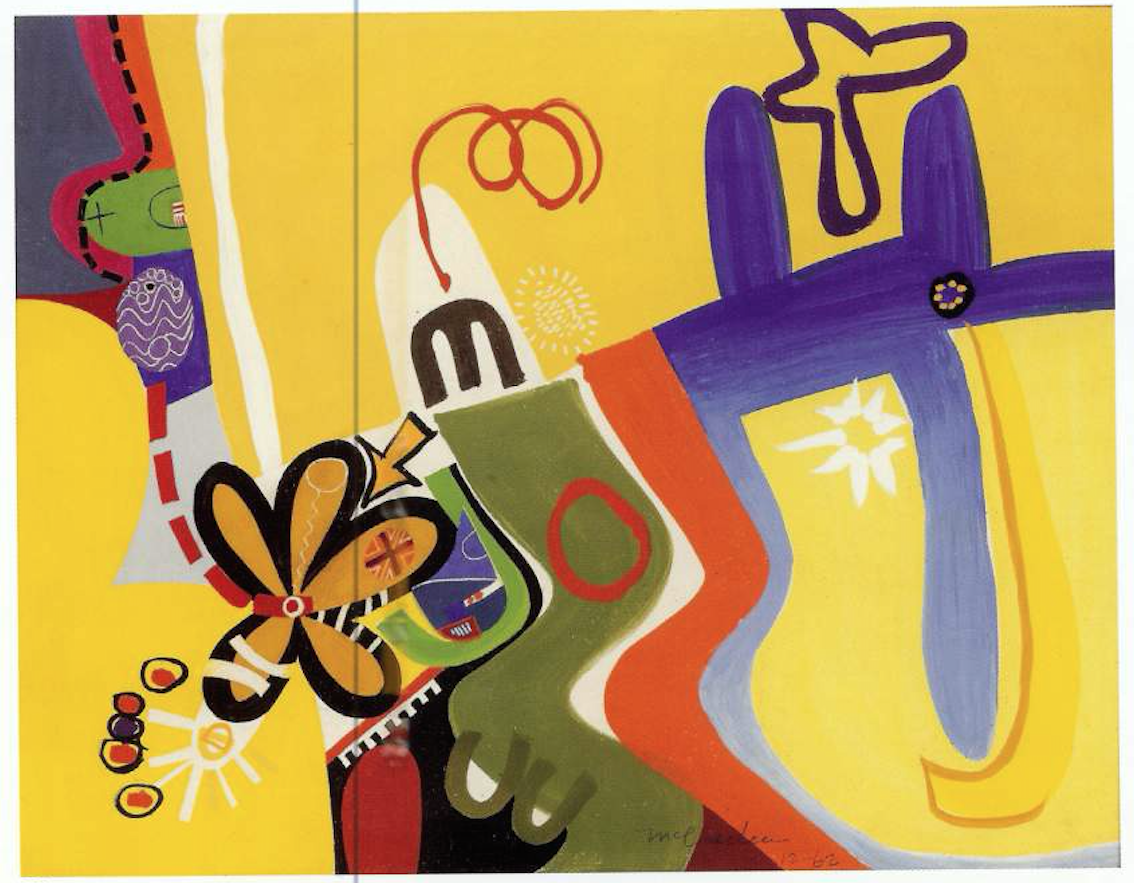
© » KADIST
John McCracken
Though not strictly representational, some objects in Untitled (1962) are recognizable: a flower, an egg, a foot. The arrows and directional lines suggest movement, but the forms they point to intertwine, prohibiting a straightforward reading. The shapes are as illustrative as a Rorschach inkblot; in their confounding, simple indeterminacy, they depict nothing and everything at once.

© » KADIST
Sheroanawe Hakihiiwe
Wateoma husipe / Larvas de oruga / Caterpillar larvae by Sheroanawe Hakihiiwe exemplify his most abstract work, where he choses particular elements of a living organism to create his renditions. During the process of depuration of forms he develops a series of translations whose inception is the daily life and culture of his community, deep in the Amazon rainforest. The works reveal structures rather than shapes, organization rather than form, exposing a way of seeing where nature and culture are not mutually exclusive but manifesting simultaneously.

© » KADIST
Rocky Cajigan
From the Ending by Rocky Cajigan consists of an assemblage painting, with accompanying sculptural objects presented on the floor. The bright pink object central to the painting is based on a photograph, and the artist’s personal memory, of a Bontoc ancestral tomb, commonly located at close proximity to a family home. The painting is covered by a net material simulating a fence, creating a certain bodily distance from the viewer’s perspective.

© » KADIST
Köken Ergun and Tashi Lama
Nepal and China signed an agreement for the Belt and Road Initiative (BRI) in 2017. The BRI is a strategy that was set forth by China in 2013 to expand its influence by building a network of economic corridors around the globe. BRI projects in Nepal include the Kathmandu-Kerung Railway, the Galchhi-Rasuwagadhi-Kerung 400 kilovolt transmission line, the 762 megawatt Tamor hydroelectric dam, and the 426 megawatt Phukot Karnali run-of-the-river hydropower project.

© » KADIST
Raymond Pettibon
The five works included in the Kadist Collection are representative of Pettibon’s complex drawings which are much more narrative than comics or cartoon. The images allude to recurring topics, such as the superhero (present both in Untitled Superman and No title without the comics ), a book cover (his literary sources), or a mushroom cloud. Inspired by the writings of William Faulkner, Daniel Defoe, Gustave Flaubert, Marcel Proust, and James Joyce, Pettibon’s sophisticated, witty drawings combine image and text to explore the gamut of American popular culture.
Raymond Pettibon
- location: Hermosa Beach, California
- year born: 1957
- gender: male
- nationality: American
- home town: Tucson, Arizona
Firenze Lai
Firenze Lai is a Hong Kong painter known for her atmospheric portraits that explore the ways in which contemporary life causes people to adjust to their surrounding conditions in disturbing ways...
Chris Johanson
- location: Los Angeles, California
- year born: 1968
- gender: male
- nationality: American
- home town: San Jose, California
Hank Willis Thomas
- location: New York, New York
- year born: 1976
- gender: male
- nationality: American
- home town: Plainfield, New Jersey
Maaike Schoorel
Based on photographs and domestic environments, Maaike Schoorel’s paintings are charged with an atmosphere of melancholy and loss...
Alexandre da Cunha
- location: London, United Kingdom
- year born: 1969
- gender: male
- nationality: Brazilian
- home town: Rio de Janeiro, Brazil
Carter Mull
Los Angeles-based artist Carter Mull is an obsessive sort, and his fascinations show through in his multimedia photographic and installation-based works...
Rocky Cajigan
Rocky Cajigan is a Bontoc Igorot artist working in the contemporary contexts of Indigenous people from the Cordilleras region in the northern state of Luzon island in the Philippines...
Conrad Ruiz
Conrad Ruiz makes watercolor paintings of fantastic scenes...
James Weeks
James Weeks, born in 1922, was an important figure in the Bay Area figurative painter tradition, with contemporaries such as Richard Diebenkorn, Elmer Bischoff, and David Park...
Sheroanawe Hakihiiwe
Sheroanawe Hakihiiwe is a Yanomami artist who lives and works in Upper Orinoco, at the Venezuelan side of the Amazon rainforest...
Fernanda Laguna
Fernanda Laguna has mobilized and influenced a whole generation of artists through her various projects since the mid-1990s...
Juan Araujo
- year born: 1971
- gender: male
- nationality: Spanish
- home town: Caracas, Venezuela
Mona Marzouk
Mona Marzouk is an artist whose practice is deeply rooted in a keen sense for architecture...
Kaoru Arima
Kaoru Arima experiments with painting in order to discover new expressive forms...
Ad Minoliti
Ad Minoliti is a painter who combines the pictorial language of geometric abstraction with the perspective of queer theory...
Mary Ann Aitken
Mary Ann Aitken was known to be very private about her art practice; she was considered somewhat of an outsider by her peers affiliated with the second wave of Detroit’s Cass Corridor arts movement...
Clare Rojas
- location: San Francisco, California
- year born: 1976
- gender: female
- nationality: American
- home town: Columbus, Ohio
Prabhakar Pachpute
Prabhakar Pachpute calls attention to issues concerning land politics, industry, and labor through a multimedia practice that includes drawing, painting, sculpture, animation, and murals...
Rebecca Quaytman
In her work, Rebecca Quaytman displays great interest in the dissolution of the image...
Young Min Moon
Young Min Moon is a Korean American artist, curator, critic, and art historian, who migrated to the United States from South Korea as a teenager...
Shimon Minamikawa
Since the beginning of his career, Minamikawa Shimon has made work that deviates from conventional painting and other formats...
Chris Duncan
Chris Duncan employs repetition and accumulation as a basis for experiments in visual and sound-based media...
Bernard Piffaretti
Bernard Piffaretti was born in 1955 in Saint-Etienne...
Simon Fujiwara
- location: Berlin, Germany
- year born: 1982
- gender: male
- nationality: British
Volker Eichelmann
Volker Eichelmann (b...
Tirdad Hashemi
Leaving Iran in 2017, Tirdad Hashemi now cultivates perpetual movement, between their hometown of Tehran, Istanbul, Paris, and Berlin...
Kadar Brock
Kadar Brock makes large-scale abstract paintings via a rigorous process of layering, erasing, and reworking his surfaces; his highly textured canvases are variously discordant, exuberant, and topographical in nature...
-
1960-1969
James Weeks
1962Both Head-Portrait with Red and Blue Background and Man with Blue Tie are classic examples of Weeks’ deftness of line, shape, and color...
James Weeks
1962Both Head-Portrait with Red and Blue Background and Man with Blue Tie are classic examples of Weeks’ deftness of line, shape, and color...
-
1970-1979
Aubrey Williams
1972Carib Carnival illustrates Aubrey Willams’s unique artistic language, combining Pre-Columbian iconography with abstraction...
-
1980-1989
El Hadji Sy
1981El Hadji Sy is an important figure in the critical movement that followed Lépold Sedar Senghor´s Négritude ideology...
Mladen Stilinovic
1985The Exploitation of the Dead cycle is composed of a very large number of elements which the artist reorganizes differently every time...
Robert Therrien
1985In No Title (Blue Chapel) Therrien has reduced the image of a chapel to a polygon...
Karen Lamassonne
1989Ventana indiscreta (Rear Window) by Karen Lamassonne takes its title from Hitchcock’s renowned 1954 classic...
-
-
2000-2009
Chris Johanson
2000Apartment on Cardboard (2000) is an exterior view of an abstracted apartment building...
Raymond Pettibon
2000Untitled (Wall Street’s Chosen Few…) is typical of Pettibon’s drawings in which fragments of text and image are united, but yet gaps remain in their signification...
Raymond Pettibon
2000The five works included in the Kadist Collection are representative of Pettibon’s complex drawings which are much more narrative than comics or cartoon...
Mary Ann Aitken
2002Untitled (Boom Box, Double-Sided) by Mary Ann Aitken is representational painting of a boom box on an unconventionally long canvas painted on both sides, to mimic the scale and appearance of the actual appliance...
Chris Johanson
2004Chris Johanson’s paintings, sculptures, and installations break down everyday scenes and commonplace dramas into colorful forms; the darkest sides of humanity are invoked with humor...
Kelley Walker
2004The triptych Black Star Press is part of the series ‘The Black Star Press project’ initiated in 2004 by the American artist Kelley Walker...
Moshekwa Langa
2004Hybridized drawing is a continued exploration in Moshekwa’s practice, integrating elements of graffiti, thread and yarn to enrich his abstract drawings of maps and space...
Alexandre da Cunha
2005His Deck Painting I recalls the simplistic stripes of conceptual artist Daniel Buren, or the minimal lines of twentieth century abstract painting, but is in reality a readymade, fashioned from repurposed fabric of deck chairs...
Juan Capistran
2005White Minority , is typical of Capistran’s sampling of high art genres and living subcultures in which the artist subsumes an object’s high art pedigree within a vernacular art form...
Raymond Pettibon
2005The five works included in the Kadist Collection are representative of Pettibon’s complex drawings which are much more narrative than comics or cartoon...
Raymond Pettibon
2005The five works included in the Kadist Collection are representative of Pettibon’s complex drawings which are much more narrative than comics or cartoon...
Shooshie Sulaiman
2005Shooshie Sulaiman’s pictures of unidentified figures initially appear alien and even monstrous: rendered hairless in unusual and even sickly colors, they stand in stark contrast to the aesthetic ideals of conventional portraiture...
Toby Ziegler
2005The Fifth Quarter might have taken its mysterious inspiration from the eponymous Stephen King story collated into the Nightmares & Dreamscapes collection...
Clare Rojas
2006Rojas’s two pieces in the Kadist Collection— Untitled (four-legged…) and Untitled (Bird’s Eyes) —are representative of her pictorial style which uses bold colorful blocks of paint and female and animal characters...
Bruno Pacheco
2006En Guard Souvenir is composed of a group of eleven elements (ten paintings on paper and a sculpture) which deconstructs and recomposes the context of Tienanmen Square in Beijing...
Annie Pootoogook
2006Annie Pootoogook created COMPOSITION (EEGYVUDLUK DRINKING TEA) at a pivotal moment in her career...
Raymond Pettibon
2006The five works included in the Kadist Collection are representative of Pettibon’s complex drawings which are much more narrative than comics or cartoon...
Felix Gmelin
2006In Untitled (after Paul Schultze Nuremberg’s Kunst) (2006), from a larger series of diptychs, Gmelin addresses the notion of entartete kunst ( “Degenerate Art”) ...
Ruijun Shen
2006In Seven Deadly Sins (2006), Shen utilizes abstraction to produce complex topographies of color that evoke associations with violently tumultuous landscapes...
Chen Shaoxiong
2007After engaging primarily with video and photography for more than a decade, Chen turned to painting to explore the issue of urban change and memories—both personal and collective...
Kadar Brock
2007Kadar Brock creates dynamic abstract paintings that are born from a process of painting, scraping, priming, sanding, and painting again...
Raymond Pettibon
2007The five works included in the Kadist Collection are representative of Pettibon’s complex drawings which are much more narrative than comics or cartoon...
Nguyen Thai Tuan
2008In the “Black Paintings” series, although the human body is only suggested, it plays an important role...
Goddy Leye
2008Strongly influenced by history and memory, Goddy Leye’s paintings are based primarily on stories and mythologies...
Clare Rojas
2008Rojas’s two pieces in the Kadist Collection— Untitled (four-legged…) and Untitled (Bird’s Eyes) —are representative of her pictorial style which uses bold colorful blocks of paint and female and animal characters...
Matti Braun
2009During a residency in 2009 at L’appartement 22 in Rabat, the artist traveled in Morocco and Senegal on the traces of the German sculptor Arno Breker...
Fred Wilson
2009Fred Wilson’s flag paintings document the 20th century history of African people, indexing the period of liberation from colonialism...
Maaike Schoorel
2009This is one of the most important works Schoorel has made to date, a triptych that has as its subject matter a garden scene with what looks like a pond...
Mary Ann Aitken
2009Untitled (Diptych) by Mary Ann Aitken is a pair of paintings; one entirely abstract and the other a hybrid of representational and abstract elements...
Federico Herrero
2009Federico Herrero’s energetic paintings reflect his experiences on the streets of his native San José, Costa Rica, and in the surrounding tropical landscape...
Heman Chong
2009With a habit of reading eight to ten books at the same time, Chong paints his two-foot tall novel covers through referencing an extensive reading list (accessible on Facebook) he has kept since 2006...
Andrew Grassie
2009In 2008, Grassie was invited by the Whitechapel Gallery to document the transformation of some of its spaces...
Conrad Ruiz
2009It may take a minute to recognize the background of New Fall Lineup – the colors are tweaked into a world of cartoon and candy, and it is covered by leaping energetic figures and flying squirrels...
Jordan Kantor
2009Lens Flare and the series Untitled Basel Lens Flare (6168, 5950, 7497) were part of a solo project by the artist presented at ArtBasel in 2009...
-
2010-2019
Etel Adnan
2010Adnan’s paintings are simple images with bold contrasting colors and rich textures...
Eric Dizambourg
2010Like the film Le Mouton noir, this dimension is counterbalanced by a burlesque element...
Chris Duncan
2010Taken from the title of the incredibly influential punk/hardcore record I AGAINST I by the Bad Brains, Untitled (blue) is an acrylic painting on reflective paper by Chris Duncan is part of a larger body of work titled EYE AGAINST I ...
Chris Johanson
2010Chris Johanson’s Untitled (Painting of a Man Leaving in Boat) (2010) pictures a canoe drifting toward an off-kilter horizon line, which demarcates the cobalt sea from the cerulean sky...
Alexandre da Cunha
2010In Laissez-Faire (Rainbow Flag) da Cunha has turned a beach towel into both a painting and a flag...
Stephen Beal
2010Beau Soleil #7 ’s title (translated as Beautiful Sun) gives a good sense of its effect...
Conrad Ruiz
2011Conrad Ruiz loves to paint subjects related to the “boy zone”: video games, weapons, games, science fiction, fantasy, and special effects...
Shaun O'Dell
2011Shaun O’Dell’s paintings, installations, videos, sculptures, and music explore the overlapping realities of human and natural structures...
Pablo Rasgado
2011Pablo Rasgado’s paintings and installations serve as a visual record of contemporary urban human behavior...
Kamau Amu Patton
2011Kamau Amu Patton’s painting Static Field I originates from a system of electronic and digital media...
Christopher Badger
2011In mathematics, the so-called geometric problems of antiquity are shapes that elude the classical tools of an unmarked straightedge and compass...
Tun Win Aung and Wah Nu
2011Tun Win Aung and Wah Nu initiated the series 1000 Pieces (of White) in 2009, as a way to produce objects and images as a portrait of their shared life as partners and collaborators...
Masaya Chiba
2011Fairy #2 (2011) depicts a surreal scene of roughly assembled household ephemera, potted plants, and a faintly visible figure rendered in thin red line...
Julian Hoeber
2011Every work in Hoeber’s 2011 series Execution Changes is titled in alphanumeric code...
Dominique Zinkpè
2012Dominique Zinkpè’s works with a wide range of materials, from jute to used cars to “hôhô” figures, which come from the Cult of Twins in southern Benin as a voodoo religion symbole of fertility...
Hank Willis Thomas
2012Bread and Roses takes its name from a phrase famously used on picket signs and immortalized by the poet James Oppenheim in 1911...
Hank Willis Thomas
2012Like many of his other sculptural works, the source of I am the Greatest is actually a historical photograph of an identical button pin from the 1960s...
Jessica Warboys
2013The ongoing “Sea Paintings” series is central to the practice of Jessica Warboys...
Firenze Lai
2013Central Station, Alignment, and Sumo are “situation portraits” that present whimsical characters within distorted and troubling worlds...
Rodney McMillian
2013In his evocative Landscape Paintings, McMillian uses second-hand bedsheets, sourced from thrift shops, as his starting point...
Firenze Lai
2013Central Station, Alignment, and Argument are “situation portraits” that present whimsical characters within distorted and troubling worlds...
Caetano de Almeida
2013Caetano de Almeida’s abstract compositions in acrylic use delicately-rendered swirls of overlapping, colorful lines...
Firenze Lai
2013Central Station, Alignment, and Sumo are “situation portraits” that present whimsical characters within distorted and troubling worlds...
Carter Mull
2013Mull’s Worker’s Clock collage works bring together images from the artist’s studio photography practice, found photographs, and pages from a phone book, laying them over a psychedelic warp of color in the background...
Scott Reeder
2013Reeder’s works often start with language—and his Pasta Paintings are no different...
Hank Willis Thomas
2013The image is borrowed from protests during Civil Rights where African Americans in the south would carry signs with the same message to assert their rights against segregation and racism...
Chris Huen Sin-Kan
2013Contrast to the bustling and unrelenting experience of a city such as Hong Kong, Chris Huen Sin Kan paints the tranquil interiors of his apartment, where he leads a modest and almost hermit-like life...
Carter Mull
2013Mull’s Worker’s Clock collage works bring together images from the artist’s studio photography practice, found photographs, and pages from a phone book, laying them over a psychedelic warp of color in the background...
James Collins
2013These two large format untitled paintings by James Collins feature the artist’s hallmark technique, which transforms abstraction into an optical illusion that creates dimension, space, and mass...
Toyin Ojih Odutola
2013Ojih Odutola uses a distinctive visual style to capture members of her family, rendering them one pen stroke at a time, until their skin resembles ribbons woven into the contours of a face, neck, or hand...
Francisco Herrero Peñuela
2014Francisco Herrero Peñuela uses old forms to make his elaborate, richly textured surfaces...
Anna Boghiguian
2014In the painting called “The Consciousness of Memory, Time, and Guilt” as in many of her recent works, the body is fragmented...
Volker Eichelmann
2014In his new series of collages, Eichelmann takes his starting point from the “Belvedere Torso” in the Vatican Museum...
Shimon Minamikawa
2014In Play , the image comes from a fashion magazine from the 1950’s (USA) whose theme is costume sportswear from the 19th century...
Paul Czerlitzki
2014In this painting made in 2014, which is part of a series started in 2013, the artist dismantles the traditional painting process...
Mona Marzouk
2014Trayvon is a series of acrylic paintings by Mona Marzouk that engages the courtroom as its points of departure...
Cheikh Ndiaye
2014Adjamé, Charbon reflects on both global environmental discourses and domestic impacts of the use and trade of coal...
Mona Marzouk
2014Trayvon is a series of acrylic paintings by Mona Marzouk that engages the courtroom as its points of departure...
Lucia Madriz
2014In her geometric paintings on wood panel, Madriz employs the Fibonacci numbers to illustrate, in simplified form, the pattern of natural plant growth—beginning from a single stem, and growing exponentially, rationally, and efficiently outward from there...
Kaoru Arima
2015Arima’s free brushstrokes gesture towards traditions in Expressionist painting, and Ticket could be seen as an attempt at “pure painting” in which the aesthetics of the medium supersede content...
Zach Reini
2015Particularly shaped by his own youth in the 1990s, his recent works have incorporated things like a marijuana leaf, a dragon-emblazoned chain wallet, metal grommets, and the ubiquitous (in the 90s) Stussy symbol...
Ruby Sky Stiler
2015The depiction of the female figure in the sculptures remains an economic, canny composition of geometric abstractions in a Modernist spirit...
Maria Taniguchi
2015Maria Taniguchi works across several media but is principally known for her long-running series of quasi-abstract paintings featuring a stylized brick wall device...
Michael Armitage
2015In “And so it is” shows the image of a faceless man before a microphone, ready to deliver an important message...
Jorge de León
2015Jorge de León most well-known work was a radical gesture, and one of his earliest artworks: in his 2000 performance, The Circle, de León sewed his own mouth closed as a protest against the silencing of citizens in the face of social corruption...
Luciano Figueiredo
2015Figueiredo’s succinct forms are rendered in bright hues of yellow, red, green, and blue, with white and black defining positive and negative spaces within the overall geometry...
Erika Verzutti
2015Made in cast bronze, Two Eyes Two Mouths provokes a strong sense of fleshiness as if manipulated by the hand of the artist pushing her fingers into wet clay or plaster to create gouges that represent eyes, mouths and the female reproductive organ...
Julia Rommel
2015On the artwork, Rommel states: “I was reading Jonathan Franzen’s new novel Purity, where they take a lot of walks through the jungle in Uruguay, or Paraguay, I can’t remember...
Daniel Boccato
2016Parrot Drawings or Paintings look like children’s drawings and seem quite innocent...
Luke Murphy
2016What Color is Luke Murphy’s outstanding digital painting that elegantly loops in nonstop motion...
Simon Fujiwara
2016Masks is a series of abstract paintings by Simon Fujiwara that together form a giant, fragmented portrait of German Chancellor Angela Merkel’s face...
Eddie Arroyo
20165901 NW 2nd Ave., Miami, FL 33127 (Botanica) is a series of paintings that artist Eddie Arroyo created over an extended period of time, depicting the same site as it appeared from 2016 to 2018...
Cally Spooner
2016The installation Self Tracking (the five stages of grief) was realized from a performance that is to be re-activated...
Antonio Caro
2016Juego de Banderas (a play on words that loosely translates to both set of flags and game of flags) is a triptych of modified Colombian flags by Antonio Caro...
Titus Kaphar
2016Although the objects depicted in Titus Kaphar’s diptych 2016/1963 might not be immediately recognizable, the work’s title and the inscriptions ‘Alabama 1963’ and ‘North Dakota 2016’ reveal their use as tools of brutal force...
Kapwani Kiwanga
2017Kapwani Kiwanga’s Linear Painting series (2017) reflect the artist’s research into disciplinary architecture, including schools, prisons, hospitals, and mental health facilities...
Imran Qureshi
2017At first glance, This Day by Imran Qureshi appears to be an energetic, gestural painting reminiscent of Action Painting from the mid-20th century...
Rocky Cajigan
2017From the Ending by Rocky Cajigan consists of an assemblage painting, with accompanying sculptural objects presented on the floor...
Jean Claracq
2017View From an Apartment features 18-year-old Joland Novaj whose image was taken from Instagram...
Rocky Cajigan
2017From the Beginning by Rocky Cajigan consists of an assemblage painting, with accompanying sculptural objects presented on the floor...
Prabhakar Pachpute
2017Prabhakar Pachpute was born in 1986 and raised in Chandrapur (Maharashtra), India, a place known as ‘The City of Black Gold’, where his family has worked for three generations in one of the oldest mines in the country...
Sadie Benning
2017In borrowing and subverting images from popular culture, Sadie Benning exposes the media’s role in constructing false and oppressive stereotypes of women, with regard to gender and sexual identity...
Korakrit Arunanondchai
2017His untitled paintings express his concern regarding perception in abstract form...
Fernanda Laguna
2017Llorar mucho (To Cry A Lot) is representative of Fernanda Laguna’s practice of the past twenty years...
Daniel Boyd
2017Daniel Boyd’s work WTEIA3 is part of a series of paintings that reference the stick charts used by indigenous communities on the Marshall Islands...
Laura Gannon
2017The impressionistic surface of Wild Money (2017) recalls the 1950s paintings of Philip Guston...
Markus Amm
2017A combination of planning and improvisation, control and lack of control, this painting is typical of Amm’s work...
Abel Rodríguez
2018Abel Rodríguez’s precise, botanical illustrations are drawn from memory and knowledge acquired by oral traditions...
Adriana Bustos
2018El mar y sus múltiples afluentes (The Sea and its Multiple Tributaries) builds on the concept of trafficking that Adriana Bustos has been exploring over the last decade...
Zhang Zhenyu
2018In DUST 171217 Zhang Zhenyu uses fragments of dust collected across the city, and then creates dark abstract paintings, repetitively gluing the material to the canvas, applying up to 30 or 100 layers and sanding until he arrives at a smooth surface...
Hulda Guzmán
2018Be Kind to Your Demons is a series of paintings by Hulda Guzmán that presents a variety of scenes in which female characters carry out ubiquitous activities in the company of secondary characters (mostly men) and devil-like creatures...
Fernanda Laguna
2018¡Qué triste estoy! (I’m So Sad) is representative of Fernanda Laguna’s practice of the past twenty years...
Christina Quarles
2018The title of the painting refers to the fact that the figure’s behind is raised upwards and the face is found at the bottom of the painting, thus inverting the way in which people are normally seen...
Jordan Ann Craig
2019Something To Do With Being Held by Jordan Ann Craig is inspired by a Cheyenne bead bag...
Maryam Hoseini
2019Secrets Between Her and Her Shadow 10 by Maryam Hoseini is from a series of paintings of the same title that are inspired by the story Layla and Majnun – an Arabic love story about Majnun, a 7th century Bedouin poet, and his lover, Layla...
Sheroanawe Hakihiiwe
2019Wateoma husipe / Larvas de oruga / Caterpillar larvae by Sheroanawe Hakihiiwe exemplify his most abstract work, where he choses particular elements of a living organism to create his renditions...
Kudzanai-Violet Hwami
2019This painting is the direct result of the artist’s research into her roots...
Citra Sasmita
2019The work Timur Merah Project 2, the harbour of restless spirit is stretched out on a full cow’s hide, replicates the Kamasan Balinese painterly language that Citra Sasmita has developed in her recent works...
Sheroanawe Hakihiiwe
2019Perawesi / Estómago de animal / Stomach of animal by Sheroanawe Hakihiiwe exemplify his most abstract work, where he choses particular elements of a living organism to create his renditions...
Rosalind Nashashibi
2019Rosalind Nashashibi’s paintings incorporate motifs drawn from her day-to-day environment, often reworked with multiple variations...
Sahana Ramakrishnan
2019Sahana Ramakrishnan’s work blends cultural influences, spanning a range of visual mythologies, she weaves together a tapestry of pop cultural references that are upended by the artist’s exploration of identity, sexuality and gender perspectives...
Noé Martínez
2019As he investigates the forms that slavery took through different events that occurred during the sixteenth century in the Huasteca region of Mexico, Noé Martínez tells, in a non-linear narrative, the history of human trafficking in Relación de tráfico de personas 1525-1533 I (Study of Trafficking of Persons 1525–1533 I) ...
Ad Minoliti
2019In Ad Minoliti’s expansive three-panel painting Abstracción geométrico-galáctica the artist’s hallmark geometric abstractions serve as playful substitutes for more straightforward depictions of the world...
Wura-Natasha Ogunji
2019Wura-Natasha Ogunji’s recent drawing of cutout figures on architectural tracing paper takes a statement by Leoluca Orlando, the Mayor of Palermo, as a point of departure for the work...
Matthew Lutz-Kinoy
2019The Lion’s Hunt by Matthew Lutz-Kinoy is a large format painting that recalls Delacroix’s paintings and tapestries from the 19th century, where the painterly surface became a garden invaded by wild beasts...
Karla Dickens
2019Karla Dickens’s collage Beneath the skim board addresses issues of discrimination and racism towards Indigenous communities in Australia through a constellation of historical and current events...
-
2020-2029
Jarrett Key
2020Jarrett Key’s practice combines several modes of production into a single frame, incorporating sculpture, painting, and performance...
Prabhakar Pachpute
2020Calling attention to campaigns for land rights, survival, and sovereignty, Prabhakar Pachpute’s recent works consider how farmers in India use their bodies in performative ways during acts of protest...
Gisela McDaniel
2020Got Your Back by Gisela McDaniel depicts two women of color from different ethnic backgrounds who share similar violent experiences...
Manuel Solano
2020Since Manuel Solano became blind, they developed a technique that relies on audio descriptions that allow for an assistant to place pins and threads on a grid that guides the artist’s hands through the surface...
rafa esparza
2020thanks for staying alive Fern.1994 by rafa esparza is from a body of work that pays homage to youth culture in the 90s...
Pu Yingwei
2020ChinaCapital: Dream, Hot Land, Interstellar Colonization by Pu Yingwei addresses a complicated phenomena of intertwined influences from different political powers, capital forces, and ideologies in the reality of China...
Antonio Obá
2020Figura Noturna II by Antônio Obá depicts a dark figure, surrounded by a halo of light set against an even darker background...
Mike Cloud
2020In his series Hanging and Beheading Paintings Mike Cloud speaks to the suffering of a series of named (and occasionally unnamed) individuals, addressing their trauma within the language of abstraction...
Dindga McCannon
2021Dindga McCannon created the radiant portrait Ima: Real Estate Mogul from the Harlem Women’s Series by first stitching material together with a sewing machine and then using more traditional painting techniques to render a portrait of Ima, a woman from Harlem who was a real estate developer from the 20th century...
Daniela Ortiz
2021The Rebellion of Roots by Daniela Ortiz depicts a series of situations in which tropical plants, held hostage in the botanical gardens and greenhouses of Europe, are protected and nurtured by the spirits of racialized people who died as a result of European racism...
Wynnie Mynerva Mendoza Ortiz
2022Wynnie Mynerva places their body at the center of their practice from an intimate perspective and healing dimension...
Köken Ergun and Tashi Lama
2022Nepal and China signed an agreement for the Belt and Road Initiative (BRI) in 2017...
Tessa Mars
2022In this untitled acrylic painting, Tessa Mars explores the long-lasting effects of colonialism on the Afro-Caribbean diaspora, particularly in terms of female vulnerability and resilience...
Richard Bell
2022For Richard Bell, art is not simply a vehicle through which to represent and convey political content...
Jared Owens
2022Hog feed 102 is an exemplary work by Jared Owens that combines two of the artist’s primary signatures: the use of soil smuggled out of the grounds at F...
Young Min Moon
2022Young Min Moon’s recent paintings repetitively portray the rituals bound up in the Korean tradition of Jesa...
Young Min Moon
2022Young Min Moon’s recent paintings repetitively portray the rituals bound up in the Korean tradition of Jesa ...
Tirdad Hashemi
2022This untitled painting by Tirdad Hasemi presents a space that can be thought of as both a prison cell and a house...
Anju Dodiya
2022The Shedding by Anju Dodiya is part of a series of mattress paintings the artist creates using fabric stretched on padded and shaped boards...
Carolina Fusilier
2023Miercoles cerca de las 7 de la tarde by Caroline Fusilier portrays two quantum computers that are mobile, with human-esque legs, these are systems at the edge of biology...



